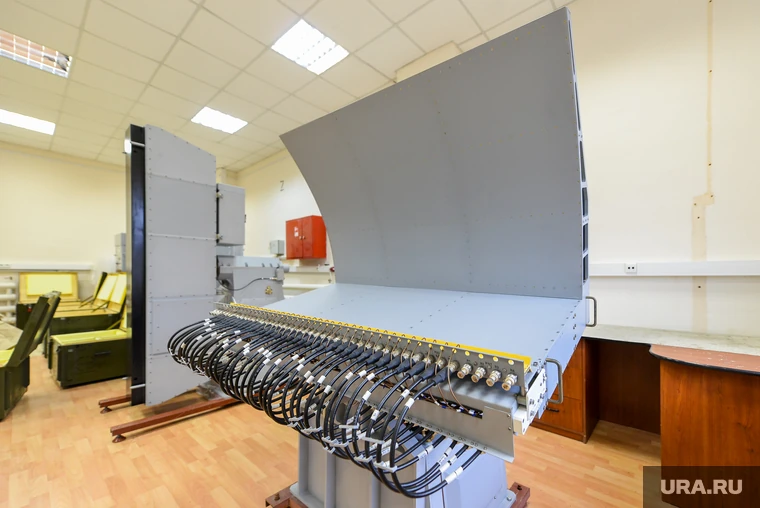The Indian Navy has begun testing the mooring capabilities of the Rezistor-E radar complex that is manufactured at JSC NIIIT-RK (named after chief designer A.M. Breygin), which is located in Chelyabinsk in the Russian Federation. This complex is responsible for automating the processes of navigation and landing of aircraft. This is being done in an effort to kickstart the air wing of the aircraft carrier INS Vikrant, which was made entirely in India. The company’s general director, Dmitry Breygin, stated on November 1 to the Russian publication URA that the subsequent stage of inspections will be finished by the month’s end.
“We made two radar systems for the aircraft carriers Vikramaditya and Vikrant. The equipment is designed for short-range navigation, flight control, (and) landing of carrier-based aircraft and helicopters,” said the head of A.M. Breygin.
“Now the specialists of our company are in India on the aircraft carrier Vikrant. The ship is on the bank, and mooring trials are being carried out,” Breygin told URA.
To be “on the bank” implies being anchored in close proximity to the shore. The inspection consists of naval architects and engineers studying the functioning of radar systems, as well as how they interface with other components of ship equipment. The investigation is being done on the technical parameters. The next step involves the Navy beginning to examine the functionality of Russian equipment by way of scheduling flying tests to evaluate it.
An autonomous control system, transmitting and receiving equipment, and industrial computers are all housed in cabinets within the Rezistor-E radar complex. In addition, there are transformers and control units, as well as switchboards, which are used to transmit electricity. A set of duplicated nodes for each subsystem is included in the product set. In the event that any of the modules fail, a backup will be activated immediately, and the damaged component can be fixed.
There are fifteen tasks handled by the computers installed onboard. The technology can be found spread out across the various sections of the aircraft carrier, and it relays in real time information to the ship’s technical specialists regarding the take-offs and landings of military aircraft. The storage cabinet for the equipment contains redundant nodes for all of the instruments and sensors.
INS Vikrant will be able to carry up to 30 aircraft, including MiG-29K fighter jets – which will be launched from its ski ramp like deck – and helicopters, in addition to defensive equipment such as surface-to-air missiles, when its air wing becomes fully operational over the next two years.
Rezistor-E radar complex
JSC NIIIT-RK was founded in 1993. The company specialises in the production of equipment for land-based and sea-based radar, as well as test equipment and equipment maintenance over the entirety of the product’s life cycle.
The Rezistor-E package is made up almost entirely (97%) of components made in Russia. The majority of the components of the complex were produced at the JSC NIIIT-RK, while some were produced by the JSC “Radiozavod” in Kyshtym.

The “Resistor-E” complex, which has already been installed on the INS Vikramaditya, is designed for short-range navigation and control of flights and landing of carrier-based aircraft of the MiG-29K type and helicopters. Its primary function is to facilitate take-off and landing operations. It is equipped with a secondary radar, an azimuth-range radio beacon, a heading glide landing system, a two-channel landing radar system, and a subcomplex for providing flight control.
With the assistance of this system, Indian pilots had completed over one and a half thousand successful landings on the INS Vikramaditya deck of their aircraft carrier by the time November 2011 rolled around.
Composition:
– azimuth-range radio beacon (ADRM), designed to provide short-range navigation of ship-based aircraft;
– secondary radar (SRL), designed to detect, and determine coordinates (azimuth and range), accompany aircraft equipped with radar transponders that respond to requests in modes “3/A, C”, “1” and “2”;
– landing radar complex (PRLC), designed to ensure the landing of the aircraft simultaneously in the instrumental mode and in the control mode according to the dispatcher’s commands;
– course- gliding landing system (CGSP), designed to provide an instrumental landing approach;
– a flight control support complex (KOUP) designed to collect and process information about the air situation and present it to the controllers of the ship’s aviation flight control group at all stages within the complex’s area of responsibility.

In order for the aircraft to communicate with the Resistor-E” complex, it is outfitted with A-380 avionics and radar transponders that are able to operate in the necessary RBS (3A/C) and Mk XII (1, 2, 3A/C) modes. Radar controlling of flights of aircraft that were not manufactured in Russia uses radar transponders that can operate in the modes described above.
The Russian Navy is replacing the older Rezistor-K42 complex installed onboard its sole aircraft carrier, the Admiral Kuznetsov, with the new Rezistor-E complex.
Indian Order
JSC NIIIT-RK is in the process of completing its shipments to India. India has ordered three of these complexes. The first can be found aboard the aircraft carrier INS Vikramaditya. The second is meant for INS Vikrant and the third will serve as the ground reference complex housed at Karwar Naval base.
As per Breygin, the second complex is installed on the ship (INS Vikrant) and is undergoing a test cycle. The third one has reached the stage where it must be accepted by its foreign partners; personnel from the Indian Navy have arrived in Chelyabinsk. It is anticipated that shipments to the customer will begin during the first half of 2023, he said.
